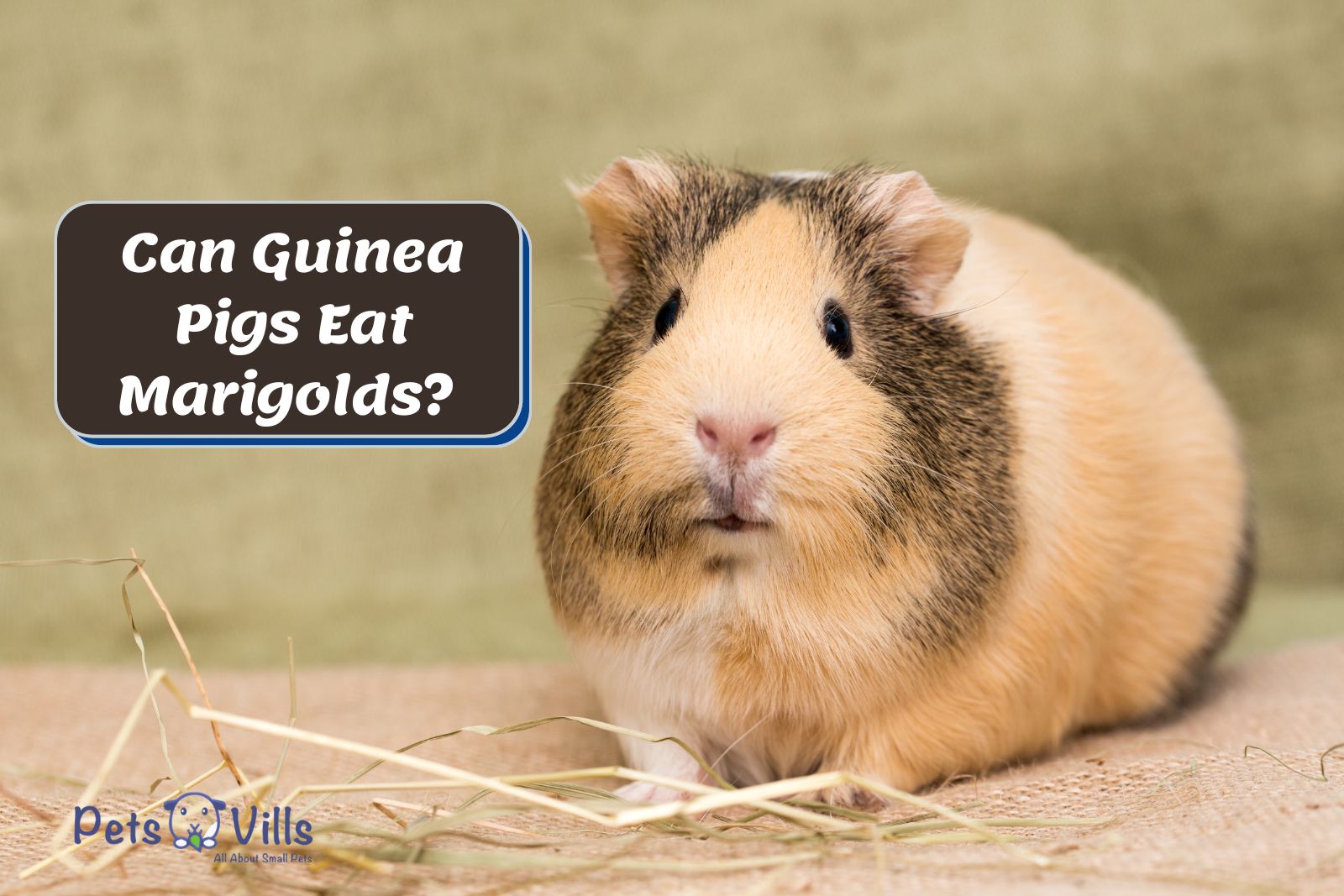Finally, your question, “Can guinea pigs eat marigolds” is about to get interesting…
A surprising fact about Marigolds is that they pack a tremendously nutritious value and are also fiber-rich.
Guinea pigs can indeed eat marigold flowers — including their leaves and stems. But, give these edible flowers in small quantities to ensure your guinea is safe.
Read further…
Table of Contents
Key Takeaways
- Certainly! Guinea pigs can eat marigolds, but only in moderation
- Marigolds may help guineas with their digestion, cell regeneration, and skin.
- Constantly monitor your guinea for any adverse effects.
Is It Safe For Guinea Pigs To Eat Marigolds?
You’ve pondered the question, “can guinea pigs eat marigolds?”. Unlike wild plants — think chickweed, dandelion, goldenrod — marigolds are a safe meal for guineas.
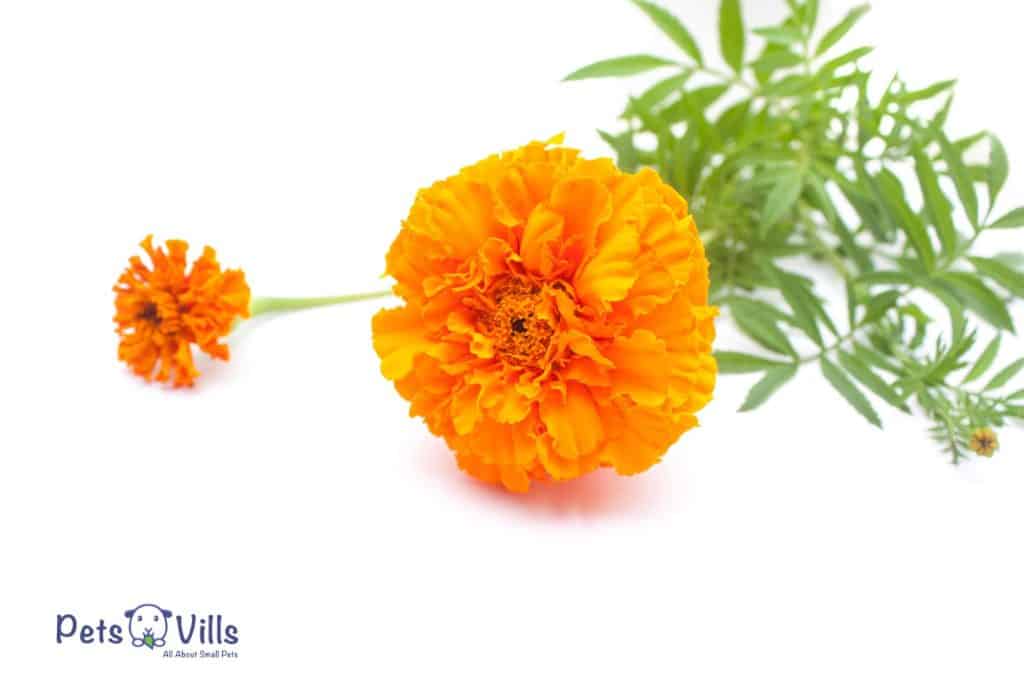
Thankfully, they are free from toxins, so they are a natural, safe option for a snack.
Still, hold tight! Marigolds aren’t precisely their staple food, so be sure to feed these flowers only in moderation.
“Yeah, so what exactly is so harmful” you may ask. Surprisingly, the marigolds are not harmful — they are relatively safe. The problem is often the chemicals.
Most people don’t consider marigolds food, so they spray almost any chemical on them — yes, those disgusting fertilizers, pesticides, and herbicides.
You might say, “but I don’t spray anything on my marigolds.” If true, that’s fine, except your neighbor, Percy, might (Ouch!).
So, for ultimate safety, please ensure that your marigolds are free from any chemicals. Otherwise, please keep them in a spot that is safe from contamination.
Chemically treated, these flowers can seriously harm anything consuming them: they could kill— including your guinea.
So please be careful!
CHECK: Can Guinea Pigs Have Watercress?
Health Benefits of Marigolds for Guinea Pigs
Marigolds are safe flowers and can supply your guineas with ample nutrition.
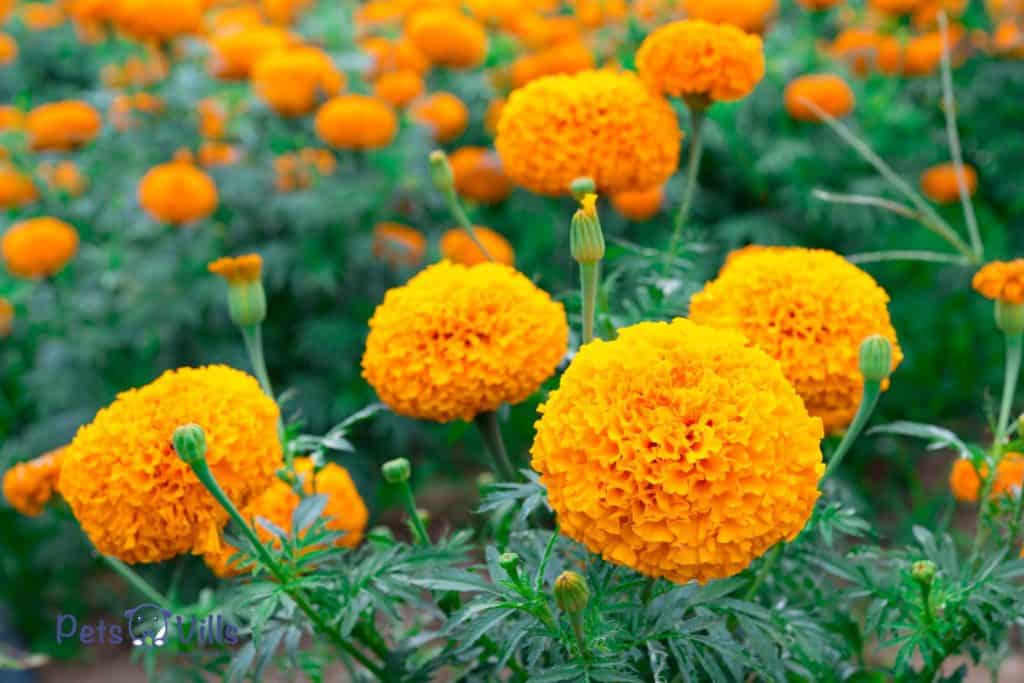
What’s incredible, the flower itself has an attractive characteristic: edible, rich in fiber antioxidants, and low in sugar.
Here are some extraordinary health benefits of marigolds:
1. Improves Digestion
Marigold is an excellent source of fiber. It’s also true that marigolds may promote your guinea with a healthy digestive system and lifestyle.
Let’s talk about fiber. Fiber is an essential carbohydrate [1] that promotes a big part of a nutritious diet.
Fiber has some astonishing advantages: it regulates bowel movement and prevents constipation.
What’s more, fiber will speed up your guinea’s digestive system by moving smoothly through its digestive tract.
This means a better food intake and a healthy lifestyle for your guinea!
2. Prevent Cells Damage
Marigolds are rich in antioxidants. This substance helps prevent cell damage in the body caused by free radicals.
Free radicals are molecules that are from the food that guinea pigs eat, from cigarette smoke, and even from radiation.
3. Lessen Skin Problems
If you know about the marigold hack to treat skin problems [2], I got news for you: you can use it on your guinea! It can be tremendously beneficial. Let me explain…
Roaming outdoors, guinea pigs are at high risk of warts, bug bites, wounds, blisters, and dry skin. What’s worse, they can get seriously sick as a result.
Thankfully, I have a solution: Marigolds.
A natural ointment, marigolds are lovely for the skin. Applying these as an ointment can be an influential asset by healing the skin and helping fight infections.
If you’re wondering whether it’s safe to give your guinea pig grass clippings, check out our article on ‘Can Guinea Pigs Eat Grass Clippings‘ for all the information you need.
Can Guinea Pigs Eat Marigold Leaves?
Yes, guinea pigs can eat marigold leaves. The leafy greens are very nutritious and can fuel your guinea with great nutrition.
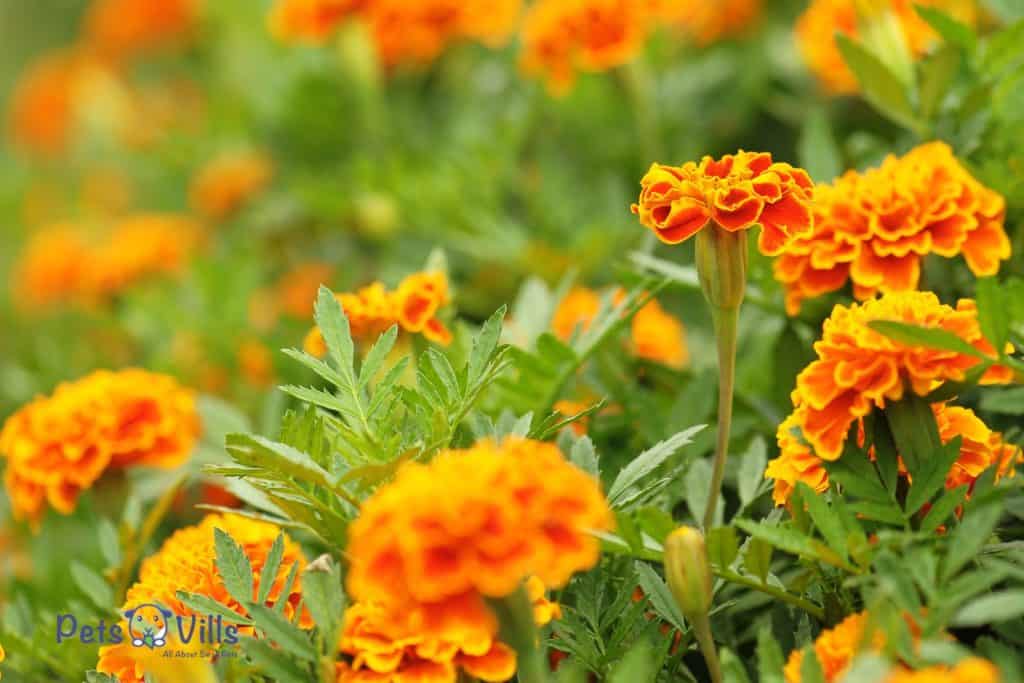
You can feed your guinea fresh leaves. Or, you can be creative and mix it with their hay, boosting their nutrition.
Again, before feeding the leaves to your guinea, ensure that it’s clean and free of any chemicals, such as those nasty pesticides and fertilizers.
How can you tell friends from foes? Inspect your marigolds for some of these classic signs of chemical contamination [3]: white spots, blotches, and droopy-looking dots.
If present, they may be a feature, or they may be toxic (yuck)! Who knows? In any case, steer clear!
And don’t think of washing them off. Sadly, these chemicals can’t be removed by washing, so inspect them thoroughly beforehand…
How To Feed Marigolds To Guinea Pigs
You can feed marigolds to your guinea as follows:
First, cut the flower from the stem, and give it a good wash. This process will help remove debris or bugs (not chemicals, though!) that may be in or on the flower.
Lastly, toss these pieces into their cage. Who knows? Your guinea might love them.
Since every part of the marigold is safe for guinea pigs to eat, you can give them the entire flower plant if you wish.
First, cut the stem close to the ground off. Then wash it under cool water to remove dirt, pests and debris.
Lastly, give them to your guinea. They will start munching and chewing on the tasty and nutritious plant. Yummy!
Another option would be adding some marigolds to their staple hay food. Place the flower in the hay and mix it up a bit.
This brilliant addition is an excellent way to shower the hay with a rich nutritious meal while letting them enjoy a tasty treat.
How Much Marigold Can A Guinea Pig Eat?
Marigolds aren’t the premium food choice to give your guinea in large quantities. Instead, give this flower in moderation.
For your baby guinea pigs, please don’t feed them any marigolds yet. Their stomachs are still developing and not strong enough yet.
For your adult guinea pig, you can feed 1 or 2 giant marigolds or 2 to 3 smaller ones (whichever you prefer!).
Guineas’ digestion system is very susceptible to wrong foods.
If this is the first time you’re feeding them marigolds, it’s best to refrain from large doses: only feed them a small amount, and monitor them like a hawk.
Even though the guineas won’t be eating a lot of marigolds at once, there could be a slight chance that they may get sick from it.
Monitor your guinea for signs such as bloating, diarrhea, and upset stomach for the first 12 hours after eating marigolds.
Feel free to offer them some more if they seem fine after that.
But, if they seem sick, STOP. Every guinea pig is unique, so don’t force them to eat it. They might prefer something more delicate.
How Often To Feed Marigolds To Guinea Pigs?
Marigolds aren’t one of their staple food, so please feed them to your guinea in moderation. Yes, once or twice per week is enough for them to enjoy this flowering plant.
If you’ve purchased dried marigold supplements, you can give them more. Make sure to follow the instructions on the package for the correct amount.
Anyhow, you always mix these tasty dry goodies into their hay.
Other Flowers That Guinea Pigs Can Eat
Dandelions
These yellow flowers will appear all over your yard during the spring and summer. Dandelions make an excellent treat for guinea pigs as they contain a lot of vitamin C.
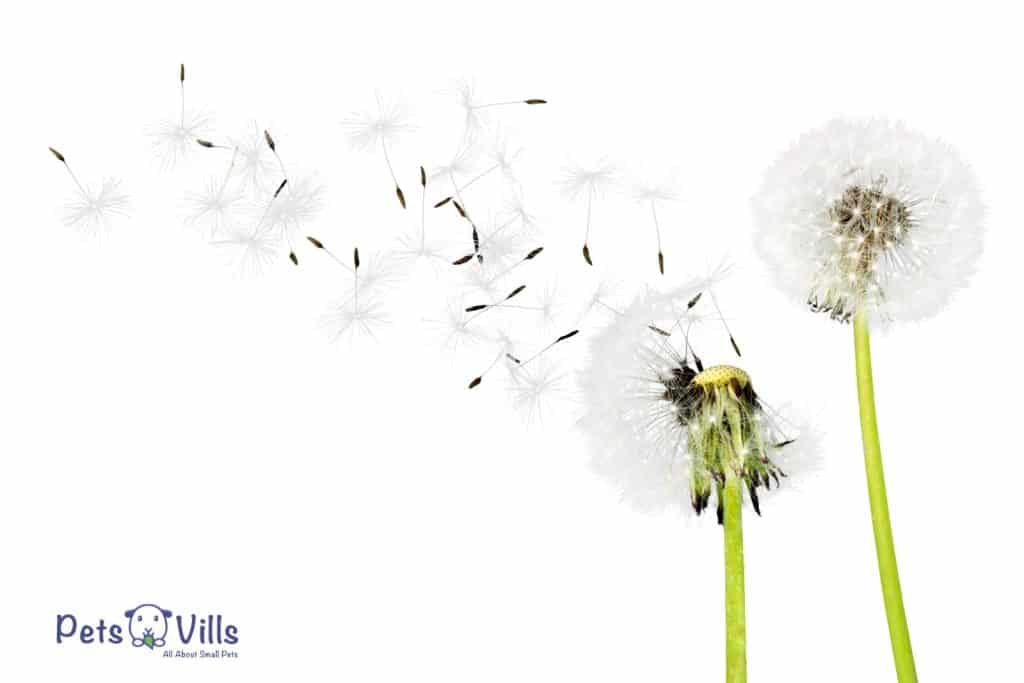
This vitamin is something that the guinea pigs can’t produce themselves, which they need a lot of to stay healthy.
You can feed every part of the dandelions to your guinea, including the root, stem, leafy greens, and petals.
Roses
Roses are an absolute delight to watch. You know what else? You can feed them to your guinea!
But, before providing them roses, make sure it has not been treated with any chemicals. Supply the roses in small quantities (5 to 10 grams, 2 to 2 times a week).
Lavender
Is lavender safe for guinea pigs?
Lavender is great for guinea pigs to eat. This flowering plant is known for its calming and cleansing properties.
Lavender is a good source of vitamin C, which the guinea pigs can benefit significantly from.
FAQs
Can marigolds make guinea pigs sick?
Marigolds fed in moderation have little chance of making them sick.
Watch out for any sign of chemical spray (For example, spots or blotches). If it does and you still feed it to your guinea, they’ll get sick.
What plants can’t guinea pigs eat?
Known for their toxicity in humans, these plants are also harmful to guineas: hemlock, nightshade, or belladonna.
Your guinea should also stay away from some common plant species exclusively poisonous to them: Lillies and rhubarb, to name a few [4].
Conclusion
So, can guinea pigs eat marigolds? Sure!
Still, prevention is better than cure, so ensure that you feed them marigolds in limited amounts first.
You want to inspect potential adverse effects and quit whenever you see them.
Now, go ahead and write about your experiences feeding your guinea! I’d like to hear from you in the comments…
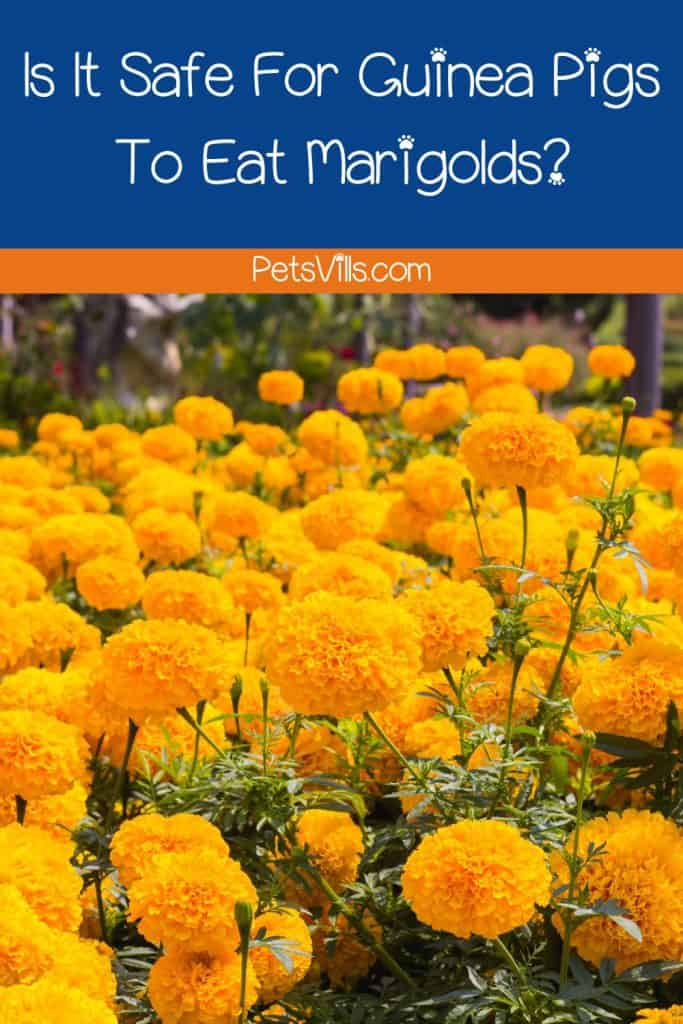
Resources
1. Contributors WE. High-Fiber Foods [Internet]. WebMD. 2020 [cited 2022 Nov 28]. Available from: https://www.webmd.com/diet/high-fiber-foods#:~:text=Fiber%20is%20a%20very%20important
2. Wilson DR. 7 Ways to Use Calendula Oil for Your Skin [Internet]. Healthline. 2018. Available from: https://www.healthline.com/health/calendula-oil#:~:text=Calendula%20oil%20is%20a%20natural
3. Fertilizer or Pesticide Burn on Vegetable Leaves | University of Maryland Extension [Internet]. extension.umd.edu. 2021. Available from: https://extension.umd.edu/resource/fertilizer-or-pesticide-burn-vegetable-leaves
4. Gill J. What weeds can you feed to guinea pigs? [Internet]. Guinea Pig Magazine. 2021 [cited 2022 Nov 28]. Available from: https://www.guineapigmagazine.com/what-weeds-can-you-feed-to-guinea-pigs/

My name is Ben Roberts, and I absolutely love animals. So, naturally, I love writing about them too! As far as my animals, I have a Pit-bull, a Beagle-lab mix, a Chihuahua, and one old cat. Each one of them provides me with a new adventure every day. And the best part is they’re all best friends. Well, except the cat when he gets a little annoyed.
FIND HIM ON: FACEBOOK and TWITTER.
Read his latest ARTICLES
Learn more about Benhere

